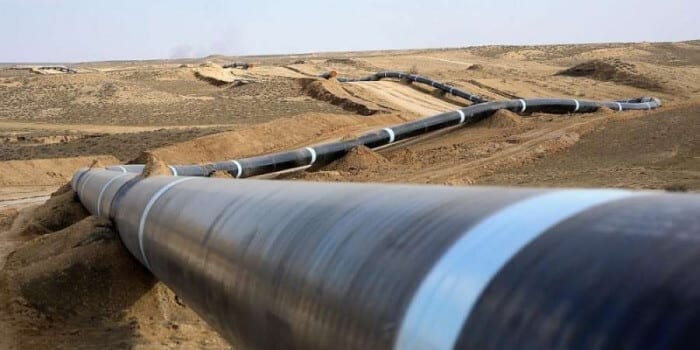On October 13, 2020, an important event in the geopolitical and energy dimensions took place, which received relatively little attention – that is technical launch of the Trans Adriatic Pipeline (TAP). It will take about a month to conduct operational testing of TAP, followed by the first deliveries of natural gas from Azerbaijan to Italy.
What is then uncommon in the event associated with putting into operation one of many pipelines running through the European continent? First, not only Italy, but all the European countries will gain access to Asian gas, which will expand the diversification possibilities for the EU countries in terms of energy sources. Second, Europe’s dependence on Russian gas supplies will sharply decrease. It should be noted that Russian gas supplies to the European market have already dropped by 20% annually with all EU gas storage facilities being overflowed.
The fact is that the launch of TAP marked the completion of the Southern Gas Corridor, as a result of the connection of three gas transportation components from the offshore fields of the Caspian Sea to the EU countries.
The first component includes the South Caucasus Pipeline also known as Baku – Tbilisi – Erzurum Pipeline (BTE pipeline). The pipeline, built back in 2006, begins at the Azerbaijani Shah Deniz gas field and passes through the Azerbaijani, Georgian and Turkish territories. Its capacity equals 20 billion cubic metres of gas a year.
The second component is the Trans-Anatolian Natural Gas Pipeline (TANAP) launched in 2018 and running from Azerbaijan through Georgia and almost the entire territory of Turkey to the Greek border. Today, Azerbaijan uses 16 bcm/year of its capacity for gas transportation, yet by 2026 this figure should access 31 bcm/year.
The third component is the recently launched TAP, which originates at the Turkish-Greek border, runs through Greece and Albania and reaches Italy. TAP is expected to transport 20 bcm/year. In addition, one TAP line from Turkey runs to Bulgaria, where it should be connected to a gas pipeline running from Bulgaria through Romania and Hungary to Austria which is currently under construction.
It is possible that the Southern Gas Corridor may acquire the fourth component in the future, which will further change the situation on the Eurasian gas market. That is about a joint idea of Azerbaijan and Turkmenistan to lay the Trans-Caspian Gas Pipeline (Baku-Turkmenbashi) between the two gas-bearing shields of the Caspian Sea. If this pipeline is built and connected to the BTE pipeline, Turkmenistan will manage to transport 30 bcm/year of its gas to Europe.
However, that is not the end. If the Trans-Caspian Gas Pipeline is implemented, it can be extended from the Turkmenbashi seaport to the gas field in Kazakhstan (Tengiz Field). Then, 60 bcm/year will be delivered to Baku from Turkmenistan and Kazakhstan for further transportation to Europe.
Although TAP ends in Italy, Asian “blue fuel” will flow further through the system of Western European gas pipelines into the EU states and the United Kingdom as well. Ultimately, though Azerbaijan, Turkey, EU countries and even the European Commission took part in that whole business with the implementation of the Southern Gas Corridor project, de facto, that is the UK which is the main driver of this project.
For the first time TAP was announced back in 2003, that is, 17 years ago! Nobody knows, would it have been built at all? But it was after London was concerned with the creation of the Southern Gas Corridor that work on the implementation of TANAP and TAP became humming. London had two reasons to take over this patronage.
The first reason, which no one conceals, is the protection of their economic interests. Thus, Great Britain is a leader in investment in the Azerbaijani economy. Today, over 500 British companies operate in the republic. In particular, British Petroleum (BP) participates in seven oil and gas projects in Azerbaijan, including the development of the Azeri-Chirag-Gunashli oil fields and the Shah Deniz gas-condensate field. Keeping going on, BP conducts geological exploration in other parts of the Caspian. BP is also the operator of the Baku-Tbilisi-Ceyhan oil pipeline and the Baku-Tbilisi-Erzurum gas pipeline. In addition, BP owns 12% of TANAP and 20% of TAP. Thus, British gentlemen had self-interest in ensuring the delivery of Asian gas to European countries, right up to the UK.
Some experts noted that Great Britain is also interested in diversifying energy sources, that is Azerbaijani gas will be helpful for the UK as well. However, this motivation is more like a plausible excuse to explain London’s focused attention to the Southern Gas Corridor, since the North Sea lies to the east of the British Isles, with the entire bottom being a series of huge gas and oil fields. Moreover, the largest hydrocarbon deposits belong to the UK and Norway. In 1998, the Interconnector gas pipeline was built between Great Britain and Belgium, designed to transport gas produced in the North Sea for the needs of the continental Europe. By all means, this gas pipeline may also be used in reverse mode, delivering gas from the mainland to the islands. However, the UK is not experiencing problems with providing “blue fuel” for its consumers so far.
Another actual reason for London to become the engine of the Southern Gas Corridor is concealed – that is protection of Europe from an aggressively-minded authoritarian Russia. By providing a steady route for natural gas supplies from Asia to the EU, the UK has loosened Europe’s energy ties with the Russian Federation. As a result of London’s efforts, the EU has become less dependent on Russian gas supplies. The reason for such UK’s stance towards Russia is not difficult to comprehend.
Though Russia occupies a vast territory, it seems to get lost in time as Russian authorities still live in the realities of the first half of the twentieth century. All that Vladimir Putin was able to achieve for 21 years of his uninterrupted reign, is that Tu-95 strategic bombers, accompanied by Su-35 fighters and A-50 airborne early warning and controlaircrafts, perform demonstration flights, violating the borders of other states and military-political alliances. The Russian Federation cannot boast of any other achievements other than blackmail and intimidation of its neighbours.
The hydrocarbons extracted on its territory are also treated by Russia as a means of blackmail and economic coercion only. Moscow has built a vast web of pipelines that carry “black and blue gold” to different ends of Eurasia. At the same time, in Russian countryside (especially, beyond the Urals, in Siberia and in the Far East), no one is concerned about the extension of gas network coverage (by 2020, only 59% of rural areas of the Russian Federation were supplied with gas). In turn, the Kremlin allots the oil and gas incomes mainly to the development of military and security constituents of the state – the army, navy, police and special services, while the average people do not feel any benefit from the energy trade. The Russian authorities are used to benefit from easy-available energy resources solely as an economic weapon rather than as an opportunity to improve the living standards of Russian citizens.
But in recent years, Moscow has far less succeeded in resorting to “energy blackmail” of other states, since not only the Russian Federation has systematically entangled the Eurasian space with its pipelines, but most other countries have successfully diversified sources of energy supplies.
Most of all, this was facilitated by the fact that the pipelines began to lose their monopoly status, since a number of countries, among which the United States are the most active, launched and built up an unprecedented trade in liquefied natural gas (LNG). Filled with LNG, tankers rushed into the seas and oceans, and most of the sea bordering states have begun construction of LNG terminals.
For example, China today receives gas not only from Russia (via the Power of Siberia pipeline), but also from Turkmenistan, Uzbekistan, Kazakhstan (via a pipeline), Myanmar (via a pipeline), Iran, Brunei, Australia and the United States (LNG). Even if the Russian Federation completely ceased gas exporting to the PRC, China could be fully satisfied with gas supplies from other sources.
Another example: Turkey has built the Blue Stream (2005) and TurkStream (2020) pipelines jointly with the Russian Federation, however, today both pipelines undergo preventive maintenance at Ankara’s initiative (although Gazprom has already executed works on a firm schedule), and no gas supplies are temporarily scheduled. Why? Because Turkey realised the essence of Russia’s energy policy in time and took an active part in the implementation of the Southern Gas Corridor project with the help of BTE pipeline, TANAP and TAP.
Nowadays the EU’s turn has come: even if the Russian Federation succeeds in construction of the Nord Stream 2 (designated solely to export gas bypassing Ukraine), the Kremlin will not be able to execute super-lucrative long-term contracts covering supply of large volumes of gas to Germany and other countries.
For many years, Moscow was committed to an insidious policy: build a pipe – sign a contract – tie the consumer to a monopoly supplier – use your position to impose terms of supply and hidden influence on the consumer’s foreign policy.
Well, now the Kremlin is no longer able to use its “energy blackjack” as effectively as it used to. In addition, Russia will find itself short of significant incomes from the anticipated sales of “blue fuel”, which will reduce funding that it spends on stirring up existing flashpoints (all-around the world) and inciting the new conflicts – in Syria, Libya, Venezuela, Ukraine, Georgia, Nagorno-Karabakh etc.

